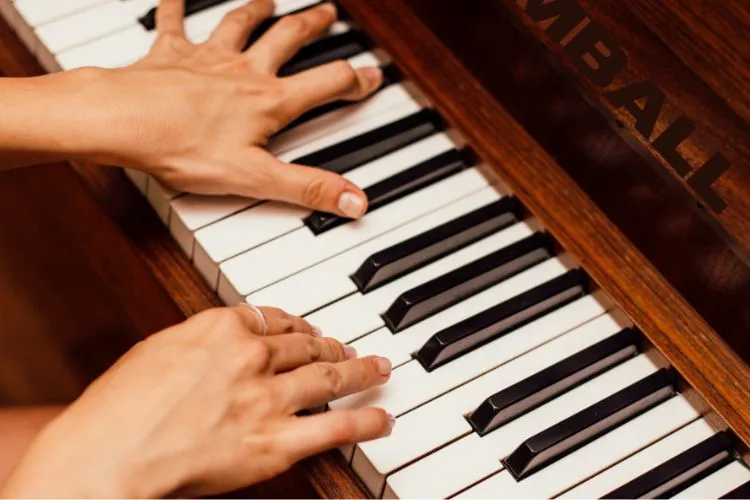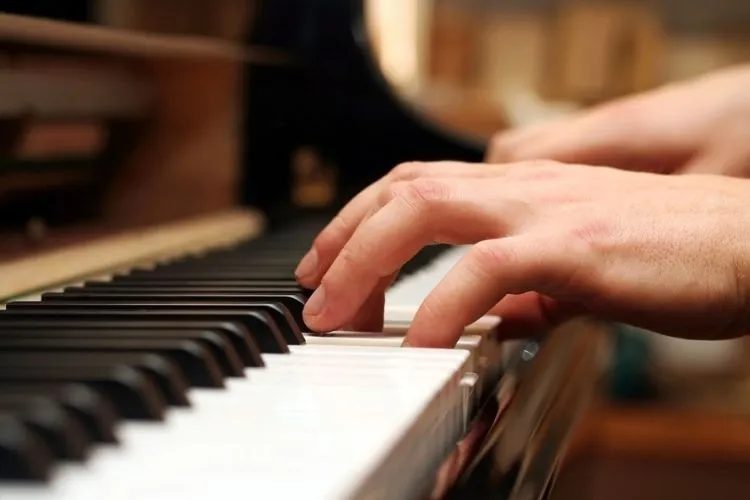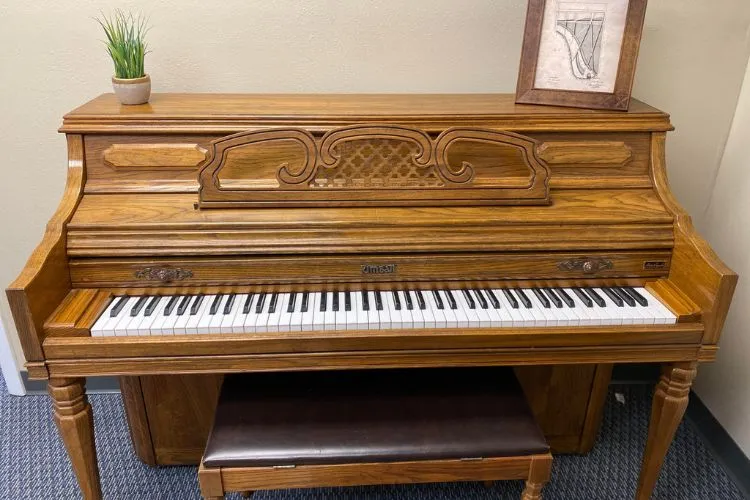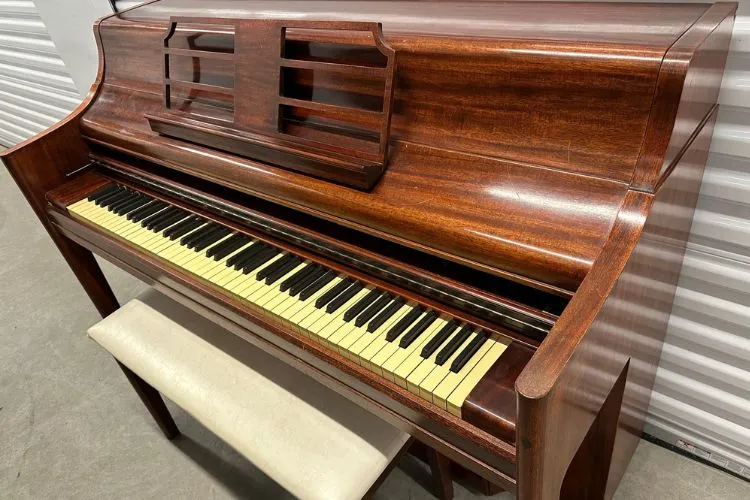There are few brands in the piano world as renowned as the Kimball Piano Company. Known for their heritage and craftsmanship, Kimball Pianos have adorned the living rooms and concert halls alike for over a century.
For those considering purchasing a piano, understanding the inherent quality that different brands and models offer is of paramount importance.
Let’s explore the legacy, quality, and value proposition of Kimball Pianos to aid you in your buying decision.

Contents
- 1 🎶Are Kimball Pianos Good?
- 2 🎶The History and Legacy of Kimball Pianos
- 3 🎶Types of Kimball Pianos
- 4 🎶Quality Analysis: Materials and Craftsmanship
- 5 🎶Sound and Playability
- 6 🎶Pros and Cons of Kimball Pianos
- 7 🎶Kimball Pianos in the Market Today
- 8 🎶Maintenance and Durability
- 9 🎶User and Expert Opinions
- 10 🎶Alternatives to Kimball Pianos
- 11 🎶frequently asked question (FAQs)
🎶Are Kimball Pianos Good?
Yes, Kimball Pianos are considered good instruments. Known for their craftsmanship and the use of quality materials, they deliver a warm and rich sound that is appreciated by both beginners and experienced pianists.
Kimball Pianos offer a range of models, from uprights suitable for limited spaces to grands that produce deeper tones for performances. While they ceased production in 1996, the pianos have maintained a reputation for durability and playability.
Their vintage charm, combined with the musical quality, makes them a valuable choice for those looking to own a piece of musical history.
However, potential buyers should be mindful of maintenance and repair needs, given their age. Overall, for those seeking a piano with character and quality sound, Kimball Pianos are a commendable option.
🎶The History and Legacy of Kimball Pianos
Kimball Piano Company has a rich history dating back to its founding in 1857 by William Wallace Kimball. Based out of Chicago, it rose to prominence for its fine instruments, especially in the late 19th and early 20th centuries.

Throughout its active years, the company garnered attention for manufacturing not just pianos but a variety of musical instruments. Kimball stopped the production of pianos in 1996; however, the musical legacy they built continues to resonate in the music world today.
🎶Types of Kimball Pianos
Kimball produced a spectrum of pianos that catered to different kinds of musicians and settings. From majestic grand pianos gracing concert halls to the compact spinet pianos perfect for residential spaces, their portfolio was diverse.
Additionally, they also produced console and studio pianos, known for their superior touch and rich tone. Each model was designed uniquely, with a distinct set of features tailored to specific needs.
🎶Quality Analysis: Materials and Craftsmanship
Examining the quality of Kimball Pianos, the essence of their artistry lies in their materials and craftsmanship. Their pianos were primarily constructed using high-quality hardwoods which ensure durability and generate excellent sound resonance.

The piano’s crafting process was intricate, with immense focus given to the design, hammers, strings, and keys, enhancing the piano’s playability and outputting a full-bodied, warm tone.
Comparatively, in the contemporary piano industry, several manufacturers focus extensively on digital production techniques. However, Kimball’s emphasis on traditional craftsmanship promises an instrument that embodies history and heritage, albeit often at a premium price.
🎶Sound and Playability
Kimball Pianos are widely celebrated for their tone and touch. The sound tends to be warm, with the upright and grand models offering more depth and resonance due to their larger soundboards.
Playability is another strength of Kimball, primarily credited to their well-designed action, allowing for a smooth, responsive playing experience that professional pianists tend to favor.
🎶Pros and Cons of Kimball Pianos
Kimball Pianos bring several advantages to the table, including a rich, hearty tone, smooth playability, and a reliable history of craftsmanship.
Additionally, given that production ceased, every Kimball Piano now also carries vintage appeal and unique historical value.
However, potential buyers might face challenges in terms of obtaining parts for repairs, owing to the company’s discontinued production.
Furthermore, due to their vintage status, some older Kimball Pianos may require significant tuning or restoration, which can add to the overall cost.
🎶Kimball Pianos in the Market Today
Today, Kimball Pianos mostly inhabit the second-hand market, with prices varying based on the model, condition, and age of the instrument.

Their antique models, especially the grand pianos, hold a relatively high value, given their rarity and historical significance. However, upright or console models are generally more affordable, making them an attractive option for first-time buyers or hobbyists.
🎶Maintenance and Durability
The hardwood construction and sturdy craftsmanship of Kimball Pianos ensure fair durability. However, like any musical instrument, routine maintenance is crucial for their longevity.
Tuning, cleaning, and occasional servicing are advisable to keep the instrument in pristine condition. Depending on its previous care, a well-maintained Kimball Piano can last several decades, providing countless hours of beautiful music.
🎶User and Expert Opinions
User and expert reviews often celebrate Kimball’s commitment to delivering quality instruments. Though they ceased production years ago, the echo of praise for their craftsmanship and tonal character remains in forums and discussions.
Several users also commend the longevity and durability of these instruments, asserting that a well-maintained Kimball Piano serves as a longtime musical companion.
🎶Alternatives to Kimball Pianos
Despite the charm of Kimball Pianos, it’s also worthwhile to remember there are many other notable brands in the market. Companies like Kawai, Baldwin, and Wurlitzer offer a range of pianos aimed at professionals and hobbyists alike.

While each brand carries its inherent strengths and weaknesses, they present viable alternatives to Kimball for prospective piano buyers.
You may also read: How To Practice Piano Without A Piano? | Does Being Left Handed Hinder Piano Playing?
🎶frequently asked question (FAQs)
Yes, their upright and console models are an excellent fit for beginners.
An appraiser or professional piano technician can help you assess its current market value based on its model, condition, and age.
While Kimball Pianos can be restored, it essentially matters if its emotional or financial value justifies the restoration cost.
The model number, often found on the piano’s harp or soundboard, helps identify a Kimball piano model. Alternatively, an expert piano technician can aid in the identification.
Conclusion:
Considering everything, Kimball Pianos are distinctive instruments with a rich history and respectable quality. They offer warmth in tone, smooth playability, and reside well within the legacy of American musical craftsmanship.
Whether you’re a beginner or a seasoned pianist, a Kimball Piano promises a unique musical experience steeped in heritage.
